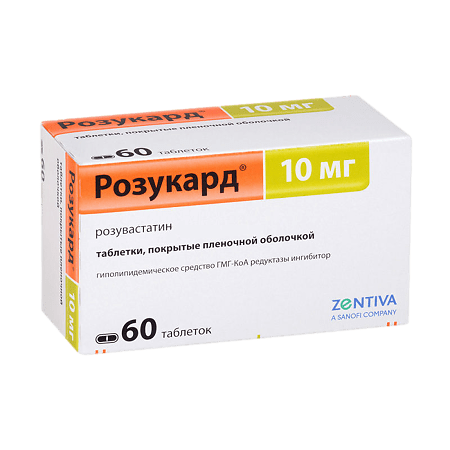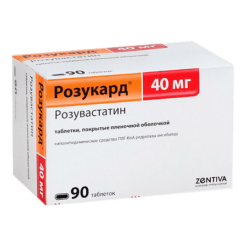No products in the cart.
Rosucard, 10 mg 60 pcs
€1.00
Out of stock
(E-mail when Stock is available)
Description
Hypolipidemic drug from the group of statins. Selective competitive inhibitor of 3-hydroxy-3-methylglutaryl coenzyme A (HMG-CoA)-reductase – the enzyme, which converts HMG-CoA into mevalonate, a precursor of cholesterol (Chs).
increases the number of LDL receptors on the surface of hepatocytes, which leads to increased capture and catabolism of LDL, inhibiting the synthesis of LDL, reducing the total concentration of LDL and LDL-LDL. Reduces concentrations of Chs-LDL, high-density non-lipoprotein cholesterol (HDL-C), Chs-LDL, total Chs, TG, TG-LDL, apolipoprotein B (ApoB), decreases the ratios of Chs-LDL/Hs-LDL, total Chs/Hs-LDL, Chs-non-LDL/Hs-LDL, ApoB/apolipoprotein A-1 (ApoA-1), increases concentrations of Chs-LDL and ApoA-1.
The hypolipidemic effect is directly proportional to the dose prescribed. The therapeutic effect appears within 1 week after the start of therapy, after 2 weeks it reaches 90% of the maximum, by 4 weeks it reaches its maximum and after that it remains constant.
Clinical efficacy
It is effective in adult patients with hypercholesterolemia with or without hypertriglyceridemia (regardless of race, sex or age), including patients with diabetes and familial hypercholesterolemia. In 80% of patients with hypercholesterolemia type IIa and IIb (according to Fredrickson classification) with baseline mean concentration of chs-LDL about 4.8 mmol/l after taking this medicine with the dose of 10 mg chs-LDL concentration was less than 3 mmol/l.
In patients with heterozygous familial hypercholesterolemia receiving rosuvastatin at a dose of 20-80 mg/day, positive dynamics of lipid profile parameters are observed.
Additive effect is noted in combination with fenofibrate for TG concentration and with nicotinic acid at lipid-lowering doses (more than 1 g/day) for decrease of HDL-C concentration.
Indications
Indications
Active ingredient
Active ingredient
Composition
Composition
Each 10 mg film-coated tablet contains:
the active ingredient:
Rosuvastatin – 10,000 mg (in the form of calcium rosuvastatin – 10,400 mg);
excipients:
core:
Lactose monohydrate – 60,000 mg, microcrystalline cellulose – 45,400 mg, croscarmellose sodium – 1,200 mg, colloidal silicon dioxide – 0,600 mg, magnesium stearate – 2,400 mg;
film coating:
Hypromellose 2910/5 – 2.500 mg, macrogol 6000 – 0.400 mg, titanium dioxide – 0.325 mg, talc – 0.475 mg, iron oxide red dye – 0.013 mg.
How to take, the dosage
How to take, the dosage
Overly, without chewing and crushing, swallowed whole with water, at any time of day regardless of meals.
Before starting therapy with ROSUKARD® a patient should start a standard hypolipidemic diet and continue it during treatment. The drug dose should be adjusted individually depending on indications and therapeutic response, taking into account current generally accepted recommendations on target lipid levels. If it is necessary to take the drug in a dose of 5 mg, the 10 mg tablet should be divided into two parts by risk.
The recommended starting dose of ROSUCARD® for patients starting the drug or for patients switching from other HMG-CoA reductase inhibitors is 5 or 10 mg once daily. When choosing the initial dose, the patient’s cholesterol content should be guided and the risk of cardiovascular complications should be taken into account, and the potential risk of side effects should be assessed. If necessary, the drug dose may be increased after 4 weeks.
With regard to the possible development of side effects when taking a dose of 40 mg compared to lower doses of the drug (see “Side effects of the drug”).
Particularly in patients with severe hypercholesterolemia and high risk of cardiovascular complications (especially in patients with hereditary hypercholesterolemia) who have not achieved target cholesterol levels when taking the 20 mg dose and will be under medical supervision, final titration to the maximum dose of 40 mg should only be performed.
Patients with hepatic impairment
In patients with hepatic impairment with Child-Pugh scores below 7, no dose adjustment of ROSUKARD® is required.
Patients with renal impairment
No dose adjustment is required in patients with mild renal impairment. The recommended starting dose of ROSUKARD® is 5 mg per day.
In patients with severe renal insufficiency (CKD less than 30 ml/min) the use of ROSUKARD® is contraindicated.
In patients with moderate renal insufficiency (CKD 30-60 ml/min) the use of ROSUKARD® in dose of 40 mg per day is contraindicated (see chapter “Contraindications).
Particular populations. Elderly patients
No dose adjustment is required in patients over 65 years of age.
Patients with predisposition to myopathy
The use of ROSUCARD® at a dose of 40 mg daily is contraindicated in patients with predisposition to myopathy (see section on Contraindications). At doses of 10 mg and 20 mg daily, the recommended starting dose of ROSUCARD® for this group of patients is 5 mg daily.
Ethnic groups
When studying the pharmacokinetic parameters of rosuvastatin an increase in systemic drug concentration was noted in Mongoloid race (see section “Pharmacokinetics”). This should be considered when prescribing ROSUCARD® to patients of mongoloid race. When prescribing doses of 10 and 20 mg, the recommended starting dose of ROSUKARD® for this group of patients is 5 mg per day. ROSUKARD® is contraindicated in mongoloid patients at a dose of 40 mg daily (see Contraindications).
When prescribing ROSUKARD® with gemfibrozil, the dose should not exceed 10 mg daily.
Interaction
Interaction
Concomitant use of rosuvastatin and cyclosporine has no effect on the plasma concentration of cyclosporine, but the effect of rosuvastatin is enhanced (its excretion slows down, AUC increases 7-fold, Cmax increases 11-fold).
Eritromycin increases intestinal motility, which leads to reduction of the effect of rosuvastatin (AUC decreases by 20% and Cmax by 30%).
In patients receiving vitamin K antagonists (e.g., warfarin) monitoring of international normalized ratio (INR) is recommended because initiation of rosuvastatin therapy or increasing the dose of the drug may increase INR, and discontinuation of rosuvastatin or reducing its dose may decrease it. Gemfibrozil enhances the effect of rosuvastatin (increases Cmax and AUC by 2-fold). Concomitant use of rosuvastatin and antacids containing aluminum and magnesium hydroxide leads to a decrease in plasma concentration of rosuvastatin by about 50%. This effect is weaker if antacids are used 2 h after taking rosuvastatin.
The concomitant use of rosuvastatin and oral contraceptives increases AUC of ethinylestradiol and AUC of nogestrel by 26% and 34%, respectively, which should be considered when choosing a dose of oral contraceptives. There are no pharmacokinetic data on concomitant use of rosuvastatin and hormone replacement therapy; therefore, a similar effect cannot be excluded when using this combination.
The results of studies have shown that rosuvastatin is neither an inhibitor nor an inducer of cytochrome P450 isoenzymes. Rosuvastatin is a non-core substrate for these isoenzymes. No clinically significant interaction with such drugs as fluconazole, ketoconazole and itraconazole metabolized with cytochrome P450 system was observed.
No clinically significant interaction of rosuvastatin with digoxin or pheno-fibrate, Hemfibrozil, other fibrates and hypolipidemic doses of nicotinic acid (at least 1 g/day) increased the risk of myopathy when used simultaneously with other HMG-CoA reductase inhibitors. It is possible due to the fact that they can also cause myopathy when used as monotherapy.
The co-administration of rosuvastatin and ezetimibe did not lead to changes in AUC or Cmax of both drugs.
Use of HIV protease inhibitors (human immunodeficiency virus) with rosuvastatin may lead to a significant increase in the effect of rosuvastatin. A pharmacokinetic study of co-administration in healthy volunteers of 20 mg rosuvastatin and a combination of two HIV protease inhibitors (400 mg lopinavir / 100 mg ritonavir) resulted in approximately two- and five-fold increases in AUC(0-24) and Cmax, respectively. Thus, co-administration of rosuvastatin with HIV protease inhibitors is not recommended in HIV-infected patients.
Special Instructions
Special Instructions
During treatment, especially during dose adjustment of ROSUKARD®, the lipid profile should be monitored every 2-4 weeks and the dose should be changed if necessary.
Liver function tests are recommended prior to initiating therapy and 3 months after the start of therapy. ROSUKARD® should be discontinued or the dose should be decreased if the serum levels of “hepatic” transaminases exceeds 3 times the upper limit of normal ranges.
When using ROSUKARD® in dose of 40 mg it is recommended to monitor renal function parameters.
In patients with hypercholesterolemia due to hypothyroidism or nephrotic syndrome the therapy of underlying diseases must be carried out before starting treatment with ROSUKARD®.
In patients with underlying risk factors for rhabdomyolysis, the balance of expected benefit versus potential risk should be considered and clinical monitoring should be conducted throughout the course of treatment.
Patients should be informed to immediately inform their physician if there is a sudden onset of muscle pain, muscle weakness, or cramping, especially in conjunction with malaise and fever. In such patients, the CPK level should be determined. Therapy should be stopped if CPK activity is significantly increased (more than 5 times the upper limit of normal) or if muscle symptoms are severe and cause daily discomfort. If symptoms disappear and CPK levels return to normal, re prescription of ROSUKARD® or other HMG-CoA reductase inhibitors at lower doses with close monitoring of the patient should be considered.
The determination of CPK activity should not be performed after vigorous exercise or if there are other possible causes for the increase in CPK activity, which may lead to misinterpretation of the results. If the baseline CPK level is significantly elevated, a repeat measurement should be performed after 5-7 days – therapy should not be started if the repeat test confirms baseline CPK activity (5 times higher than normal).
Routine monitoring of CPK activity in the absence of symptoms is inappropriate. An increased incidence of myositis and myopathy has been reported in patients taking other HMG-CoA reductase inhibitors in combination with fibrin acid derivatives (including gemfibrozil), cyclosporine, nicotinic acid, azole antifungals, protease inhibitors and macrolide antibiotics. The expected benefit versus potential risk should be carefully weighed if ROSUKARD® and fibrates or nicotinic acid (at least 1 g/day) are used concomitantly; concomitant administration of gemfibrozil is not recommended.
In most cases, proteinuria decreases or disappears during therapy and does not indicate the onset of acute or exacerbation of existing renal disease. Assessment of renal function should be performed in the routine evaluation of patients receiving a dose of 40 mg.
Women of reproductive age should use adequate contraceptive methods. Since cholesterol and cholesterol-synthesized substances are important for fetal development, the potential risk of HMG-CoA reductase inhibition exceeds the benefits of using the drug during pregnancy. If pregnancy occurs during therapy, the drug should be discontinued immediately. There are no data on excretion of rosuvastatin with women’s milk, therefore breastfeeding should be discontinued.
The co-administration of rosuvastatin and HIV protease inhibitors is not recommended.
In long-term use of rosuvastatin, single cases of interstitial lung disease have been reported. If interstitial lung disease is suspected, therapy with ROSUQUARD® should be discontinued.
In studying the pharmacokinetic parameters of rosuvastatin, an increase in systemic drug concentration has been noted in people of mongoloid race (see section “Pharmacokinetics”). This fact should be considered when prescribing ROSUCARD® to patients of mongoloid race.
Impact on ability to drive motor transport and operate machinery.
Caution should be exercised when driving vehicles and engaging in activities requiring increased concentration and rapid psychomotor reactions (dizziness may occur during therapy).
Contraindications
Contraindications
Side effects
Side effects
The frequency of adverse reactions was determined according to the following grading (World Health Organization classification):
Overdose
Overdose
The pharmacokinetic parameters of rosuvastatin do not change when multiple daily doses are administered simultaneously.
Treatment:There is no specific treatment, symptomatic therapy to maintain the functions of vital organs and systems is carried out. Control of liver function and CPK activity is necessary. Hemodialysis is ineffective.
Similarities
Similarities
Additional information
| Shelf life | 2 years |
|---|---|
| Conditions of storage | In a light-protected place at a temperature not exceeding 25 °C. |
| Manufacturer | Zentiva k.s., Czech Republic |
| Medication form | pills |
| Brand | Zentiva k.s. |
Other forms…
Related products
Buy Rosucard, 10 mg 60 pcs with delivery to USA, UK, Europe and over 120 other countries.

















